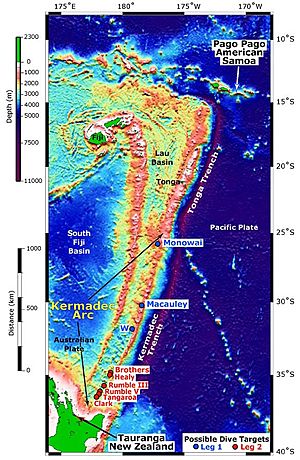Kermadec Trench facts for kids

The Kermadec Trench is a very deep ocean trench found in the southern Pacific Ocean. It's like a long, narrow valley at the bottom of the sea. This trench stretches for about 1,000 kilometers (620 miles). It goes from the Louisville Seamount Chain in the north to the Hikurangi Plateau in the south, located northeast of New Zealand's North Island.
The Kermadec Trench is connected to the Tonga Trench further north. Together, they form a huge underwater system called the Kermadec-Tonga subduction system. This system is about 2,000 kilometers (1,240 miles) long. It started forming a long time ago, when the Pacific Plate began to slide under the Australian Plate. This process is called subduction, and it's happening very quickly in this area.
Contents
What is the Kermadec Trench?
The Kermadec Trench is one of the deepest ocean trenches on Earth. It reaches an amazing depth of 10,047 meters (32,963 feet). To give you an idea, that's deeper than Mount Everest is tall! This trench was formed because the Pacific Plate is slowly sliding underneath the Indo-Australian Plate. This process is called subduction.
The trench runs next to and east of the Kermadec Ridge and its chain of islands. The Tonga Trench continues this deep valley to the north.
How the Trench Was Formed
The Kermadec Trench is very straight and simple in its shape. This is because the seafloor that is sliding underneath is very uniform. This seafloor was created at a place called the Osbourn Trough, which is now extinct. The seafloor near the northern end of the trench is about 72–80 million years old. Near the southern end, it's even older, more than 100 million years old.
The Hikurangi Plateau is a large, flat area on the seafloor. It was once part of a huge area of volcanic rock. This plateau is now slowly sliding under the southern part of the Kermadec Arc. Most of it has already gone deep into the Earth.
Amazing Animals of the Kermadec Trench
The Kermadec Trench is home to some truly unique and strange creatures that can survive in extreme conditions.
Giant Amphipods
In 2012, scientists exploring the trench found a species of giant amphipod. Most amphipods are only about 2.5 centimeters (1 inch) long. But these giants can grow up to 34 centimeters (13 inches) in length! They are also a milky-white color.
Deep-Sea Fish
The second-deepest fish ever found is the hadal snailfish, known as Notoliparis kermadecensis. This fish lives only in the Kermadec Trench. It can be found at depths between 6,472 and 7,561 meters (21,234 to 24,806 feet).
Another interesting fish is a type of pearlfish called Echiodon neotes. This fish has been caught in the trench at depths of 8,200 to 8,300 meters (26,900 to 27,200 feet). This is very unusual because most other known pearlfishes live in much shallower waters, around 1,800 to 2,000 meters (5,900 to 6,600 feet) deep. Scientists are still trying to understand why E. neotes lives so much deeper.
Nereus Research Submarine
In May 2014, a special unmanned research submarine called the Nereus was exploring the Kermadec Trench. It was operated by the Woods Hole Oceanographic Institution (WHOI). Sadly, the submarine broke apart due to the incredibly high pressure at a depth of 9,990 meters (32,776 feet).
See also
 In Spanish: Fosa de Kermadec para niños
In Spanish: Fosa de Kermadec para niños

